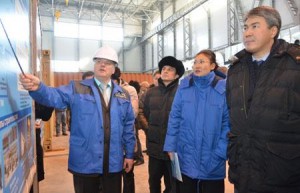 UST-KAMENOGORSK – Deputy Prime Minister and Minister of Industry and New Technologies Asset Issekeshev viewed State Programme of Accelerated Industrial-Innovative Development (SPAIID) projects on a working trip to the East Kazakhstan region in late February and said at least five joint projects with transnational companies will be launched in the region within the second five-year segment of the programme.
UST-KAMENOGORSK – Deputy Prime Minister and Minister of Industry and New Technologies Asset Issekeshev viewed State Programme of Accelerated Industrial-Innovative Development (SPAIID) projects on a working trip to the East Kazakhstan region in late February and said at least five joint projects with transnational companies will be launched in the region within the second five-year segment of the programme.
Issekeshev discussed the projects during a working trip to the region with one of the so-called national information groups to explain the main thrust of the Kazakhstan Way 2050, President Nazarbayev’s recent state-of-the-nation address.
Akim (Governor) of the region Berdybek Saparbayev accompanied the delegation during the visit to the full-cycle car assembly plant and technology park for producing car parts now under construction. The cost of the project, implemented by Asia Auto Kazakhstan and the Renault-Nissan alliance, is 74.5 billion tenge (US$404.7 million), nearly 15 billion tenge or US$81.5 million of which is the companies’ own funds with the rest coming as loans from the Eurasian Development Bank and the European Bank for Reconstruction and Development. The design capacity of the future plant is 120,000 vehicles per year and half the output will be exported.
Another investment project is the POSUK Titanium LLP plant of titanium ingots and slabs, which the Ust-Kamenogorsk Titanium-Magnesium Plant and one of the world leaders in metallurgy, the South Korea-based POSCO, plan to launch in 2014. The new facility will produce 6,000 tonnes of titanium products per year, which is 60 percent of domestic demand for these goods. South Korean partners have invested 11 billion tenge (US$59.7 million).
Issekeshev’s next destination was the Aitas-IP LLP deep processing poultry plant with a design capacity of 12,000 tonnes per year. Almost a third of the 1.8 billion tenge (US$9.8 million) is the company’s own funds.
In the past four years, 37 projects worth 190.7 billion tenge (about US$1 billion) were commissioned in the oblast within the Industrialisation Map and 3,700 new jobs were created.
2014 is the final year in the implementation of the first five-year plan of the SPAIID. By the end of 2014, 14 investment projects totalling 17.5 billion tenge (US$95 million) and creating 1,500 jobs in the east of the country are planned within the Industrialisation Map.
After the project visits, the implementation of SPAIID, including the region’s specialisation in the second five-year plan of industrialisation, was discussed in a meeting.
“Traditionally, the region is considered one of the metallurgical centres of the country. Lately, the engineering sector has also been developing dynamically here. However, it is necessary to study the potential of other sectors that could become new points of growth,” Issekeshev said.
He also noted the region’s activity in implementing SPAIID projects. Last year, the volume of industrial production in the region reached one trillion tenge (US$5.4 billion), and the processing sector accounted for 80 percent of this figure. Following the meeting, two memoranda were signed. The regional akimat (administration) and the Ministry of Industry and New Technologies agreed to cooperate in the sphere of tourism, and the Ministry of Industry and New Technologies and the Kazzinc mining company agreed to work to improve the efficiency of geological exploration programmes and increase the mineral resource base on the “Great Altai” project.


